| 1 | The deadliest cobra of all |
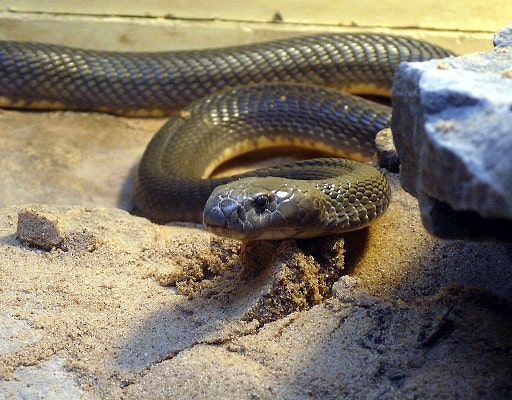
The true cobra genus (Naja) boasts 34 members as of 2024, each assigned its own countries to rule over by the snake gods. The Caspian cobra is the resident species of southern central Asia, controlling a large swathe of mainly dry, dusty territory. Their empire begins in Turkmenistan to the west, continues through Afghanistan, Uzbekistan, Pakistan and Tajikistan, and fizzles out in northeast India, where they have a small area of overlap with the Indian cobra (Naja naja).
While most cobras can kill, the Caspian cobra is routinely estimated as the worst species of all, placed at the very summit of mount venom. For example, a study covered 136 Caspian cobra bites from 1979-1987, when its territories belonged to the Soviet Union. 121 received antivenom, of whom a reassuring 113 survived. But among the 15 who didn’t receive antivenom, 11 died, making for a mortality rate of 73%.
Though they climb trees occasionally, dense forests are a no-go for Caspian cobras. Their favourites are dry rocky foothills and dry shrubby foothills, with wide views stretching into the distance. They tend to appear at higher altitudes than Indian cobras, which mainly stick to below 900 metres.
| 2 | Twitchy and nervous |
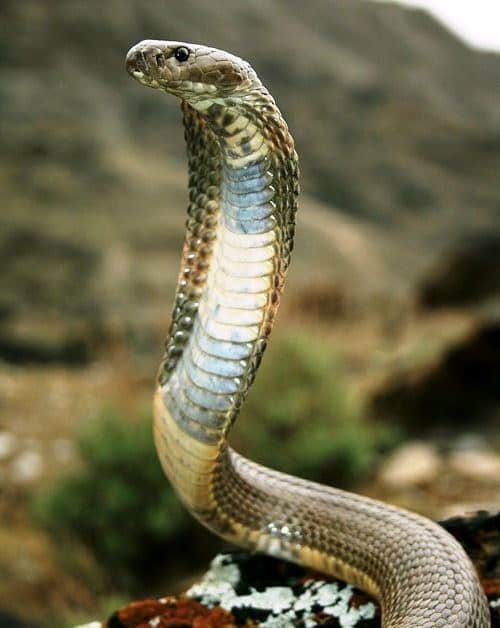
Unlike cottonmouths, which unleash skin tissue chaos but are rarely fatal, Caspian cobra bites kill with ease. One estimate is a 75% fatality rate for untreated patients, with death sometimes arriving within 45 minutes. Statistics bear out the caspian cobra’s vicious reputation. The LD50 toxicity rating, the quantity that kills 50% of creatures it is injected into (in this case mice), was estimated at 0.14mg in 2019, and 0.2mg in an older study. This compares to Indian cobras at 0.28mg, Egyptian cobras at 0.19mg, and cape cobras at 0.4mg.
The venom yield isn’t gigantic but perfectly respectable, at 75-125mg. What’s more worrying is the caspian cobra’s twitchy speed, rapid strikes and generally nervous personality. Despite being a slithering chemical tank, this cobra is convinced that its survival is constantly under threat. It just sees a large menacing shape looming over it, and doesn’t have the instincts to realise that great apes like humans don’t eat serpents as a part of their diet.
It’s said that penguins have no fear of human explorers docking in Antarctica, because they have no land predators. People can walk between them and admire their silly and cute ways for hours without being subject to a ferocious flapping flipper attack. But caspian cobras have evolved a general fear of everything, and this makes them treacherous to meet while closing the gate to your dry sheep field.
| 3 | ID sign: no hood marking |

This species averages at 1-1.2 metres, with a maximum known so far of 1.7 metres, making them slightly shorter than Indian cobras. As ever, Caspian cobras are capable of elongating their ribs to form an intimidating hood. Their signature chest pattern is alternating gold and black stripes.
There’s an easy ID sign to separate them – no hood marking, just a plain colour instead. Indian cobras usually have two round spectacle markings on the back of their head, while Thai monocled cobras have a single round circle. Caspian cobras have nothing.
Additionally, Indian cobras have a pair of large black spots adjacent to the throat (see here), whereas Caspian cobras have a few dark speckles here and there, but not as large and dark as these. Then there’s technical differences, as Naja oxiana has a higher number of ventral (belly) scales than its cousins. Caspian cobras have a black tongue and unlike a viper, their pupils are round.
| 4 | Slurred speech and paralysis |
Like many cobras, caspian cobras are extremely neurotoxic, covering all the bases of their Egyptian and Indian cousins. Classic symptoms include hypotension, general weakness, lethargy, throat paralysis, and decreased control of the extremities. This is followed by slurred speech, convulsions, migraines, and in the worst cases, respiratory paralysis and death. Even hallucinations have been reported. Survival isn’t assured, but if victims do walk out the hospital doors, the may face long term consequences like internal organ and nerve damage.
The most extreme study came from Iran, involving 53,787 snakebites reported to hospitals from 2002 to 2011. 118 of those were far from Caspian cobras, just a small fraction. But the deaths were highly disproportionate. 67 deaths were reported overall, achieving just 0.12% of the snakebitten population. Yet with caspian cobras, 51 victims died, a fatality rate of 43.22%. 46 didn’t receive antivenom, including one 10 year old boy who died en route to hospital, 35 minutes after envenomation. A further 5 received antivenom, but succumbed anyway. Antivenom seems particularly weak against the caspian cobra, and larger doses are required than for other cobra species.
One study compared the two cousins, and found that Indian cobra venom was much more diverse, with 34 protein families identified versus 24 in Naja oxiana.
| 5 | Strike style |
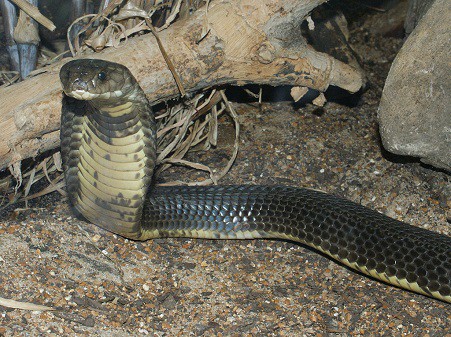
Everyone knows that a cornered cobra will rear up its chest, hiss and strike at the aggressor if they fail to heed the message. A 2016 study delved deeper in the Caspian cobras’s exact defensive style. It involved 6 wild Caspian cobras, gathered from the Iranian province of Khorasan. Each snake was subject to 3 behavioural trials, lasting for a minimum of 2 minutes each. The cobras were kept healthy, on a diet of rodents, rather than starved, which can pump up a creature’s aggression levels.
As expected, all the cobras reared up vertically, in classic cobra style. The cobras elevated 13-22% of their body while in this posture. Every strike was from their classic vertical chest position, although with each successive strike their starting point got lower. Interestingly, there was a significant negative correlation between total length and willingness to strike. The smallest two cobras struck much more frequently, accounting for 17 of 27 strikes. 100% of the cobras that reared up defensively spread their hood (which is narrower than an Indian cobra’s).
Over the 18 behavioural trials, they recorded 31 hisses in total. Most were shorter bursts, while a few were longer and drawn out. All these longer hisses took place while reared up vertically in their warning stance. All 27 strikes were accompanied by a hiss.
| 6 | Tongue flecking = danger |
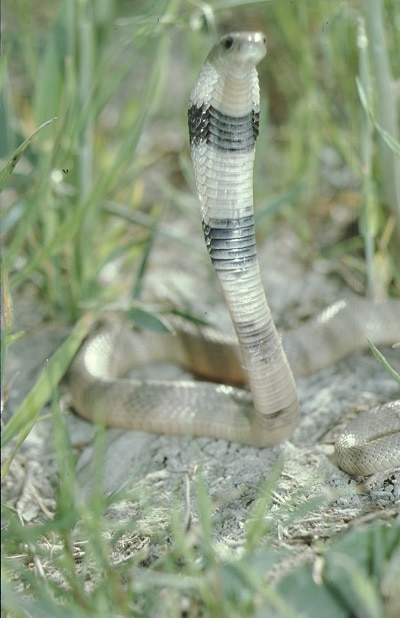
The scientists found that the caspian cobras “showed little tendency to flee or attack”. In other words, they stand stood their ground, rather than zooming up a dry hillside. But they weren’t quite as bloodthirsty as reputed. Over the 18 trials, there were 27 strikes against the researchers. One was with the fangs bared, with full intention to kill, but 26 were mere sham strikes with the mouth kept closed. All the snakes began breathing more heavily post strikes.
After a strike, the caspian cobra’s tongue flecking accelerated. The average fleck lasted 1 second, but some determined cobras waggled their tongue for 5 or even 10 seconds. Weirdly, it varied between cobras, as two of the Naja oxiana flecked their tongues for 2-3 times longer on average than the rest.
The tongue fleck rate was correlated with everything: body height, strike rates, hissing frequency. Tongue flecking had the tightest correlation to the cobra’s overall level of nervousness, and willingness to enter battle.
The scientists also concluded that caspian cobras rely heavily on visuals. For example, a cobra in its early ecdysis (skin shedding) phase was less willing to attack, and ecdysis affects their vision, as evidenced by the blue eyes.
| 7 | Thankfully unable to spit |
The scientists then mentioned other cobras, such as African forest cobras, which elevate far more of their body vertically, up to 50% versus 13-22%. They actually advance on aggressors while raised up, and perform more real strikes, whereas the Caspian cobras stayed still and performed mock strikes.
One skill the caspian cobra completely lacks is spitting venom. There are no tiny holes in the bottom front of their fangs which shoot pressurised jets into people’s eyes. The monocled cobra of Thailand was long considered to be non-spitting, until occasional reports of spitting appeared from West Bengal, India. However, the same hasn’t happened for Caspian cobras (nor the Indian cobra).
But they do contain a toxin which can break down RNA: Ribonuclease V1. Originally, extracted from Caspian cobra venom, this now used by scientists in laboratories, in molecular biology experiments.
Naja oxiana doesn’t just paralyse your every muscle, but has the speciality of damaging your heart. Caspian cobra venom has caused at least one confirmed heart attack in humans, and the cardiovascular effects are strongest in the first few hours.
| 8 | Targets the heart too |
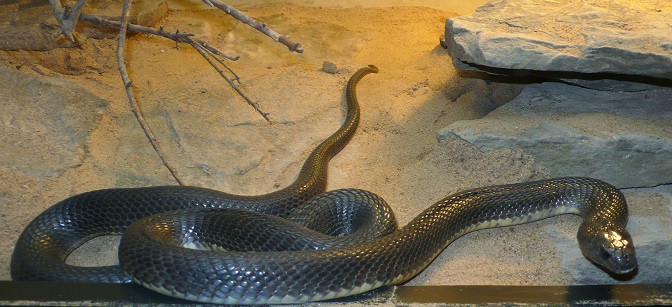
A 2016 study injected Caspian cobra venom into rabbits. The study tested three bloodstream biomarkers which correlate closely with heart damage: creatine phosphokinase (CPK), lactate dehydrogenase (LDH), and creatine kinase-MB (CK-MB). Creatine kinase, for example, is released into the bloodstream after muscle tissue damage, but the MB stands for myocardial band, and delves deeper to specifically reveal heart tissue damage.
After injection with Naja oxiana venom in rabbits, all three biomarkers rose, particularly in the first four hours. CPK lasted the longest, rising by 257% after 1 hour, and remaining 99% above baseline after 24 hours. The other two rose quickly but fell sharply by 24 hours. CK-MB was elevated by 85% at 1 hour, while LDH reached 153% above baseline. These tests are regularly used in human heart disease patients.
The study concluded that “Naja naja oxiana venom has acute effect on cardiac system during the first few hours of snake bite“. Several studies on rats, meanwhile, have found that Naja oxiana affects the contractile ability of the heart muscle, partly by affecting the transport of calcium ions, causing an overload of intracellular calcium, which is similar to the notorious bufotoxins found in toads (including the American toad and cane toad).
| 9 | Almost no diet information |
Diet is the one area where Caspian cobras have barely any research. Reptiles such as the striped grass mabuya are confirmed, but there are no detailed diet studies involving 100-200 Caspian cobras where each belly is plundered. There’s one confirmed snake prey though – Hodgson’s ratsnake, a harmless constrictor with green tinges.
In 2020, scientists found a Caspian cobra measuring 119cm, in a villager’s house in Himachal Pradesh, India. It was swallowing a Hodgson’s ratsnake measuring 92cm, which it regurgitated in fright once the scientists arrived. The second case happened in another village 2.37km away. The Hodgson’s ratsnake was one third swallowed, but again, the Caspian cobra regurgitated its prey when spooked by the gathering crowd. It fled into a burrow, and returned later to secure its ratsnake meal, but lost its nerve and fled once again.
Most true cobras get a chunk of their meals from serpents, say 10-20%. The cape cobra’s diet once came in at 32% snakes. It’s possible that Caspian cobras are even more addicted to serpents than their cousins, or maybe not. Those stories also show how twitchy their personality is.
| 10 | Evolution of the Caspian cobra |
The exact origins of the many cobra species haven’t been pinpointed, but a 2020 study gave it a good go. It found that within the east Asian cobra sub-clan, the Indian cobra formed the baseline of the evolutionary tree. Sprouting from this were two broad clades: the southeastern clade including spitters such as Javan spitting cobras, Philippine cobras, etc, and then a clade further north containing monocled, Chinese, Caspian and Andamam cobras, which were more closely related.
The study estimated that Caspian cobras diverged from monocled and Andaman cobras (their closest relatives) approximately 3.21 million years ago. The latter two diverged 1.81 MYA, while Chinese cobras split off from the pack slightly earlier, around 3.98 MYA. This 4 member subgroup, consisting of non-spitters or occasional spitters, split off from the full spitters like the Philippines cobra 6.07 MYA.
Exactly what caused caspian cobras to diverge is mysterious. One likely player is the barrier of the Hindu Kush mountain range. These run through Afghanistan and Pakistan, and reach 7708 metres at the highest point (Tirich Mi), the highest mountain on Earth outside the Himalaya. When ice ages arrived millions of years ago, the valleys of this towering mountain range possibly become too frigid for cold-blooded snakes to cross. The cobras to the northwest were separated, allowing them to gradually evolve into a new species. Once the climate warmed, they gradually filtered back into northwest India, but were now too genetically separated to interbreed with Indian cobras, and remained independent.
But there’s also harsh desert areas in its southern territories in Afghanistan, directly south of the Hindu Kush. It’s possible that the Hindu Kush was always too harsh and high to cross, but that during ice ages, these southern areas became milder, allowing caspian cobras to cross, before heating up again and cutting them off, keeping them in the evolution pressure cooker. Then they cooled down again, allowing Caspian cobras to recolonise extreme northwest India, having become a new species. The question remains unanswered.
